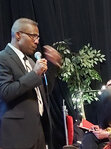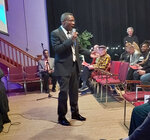By Cam Gordon
There is a new, detailed plan that would transform 3000 Minnehaha Ave into a “Black Cultural Center.”
The plan for the city-owned site was presented Jan. 29 at the Hook and Ladder Theater that is located next to the boarded up 3rd precinct police station at Lake St. and Minnehaha.
Advertised as a “vision,” the presentation in January included detailed renderings of the site. A memorial wall and garden could stand where the building is currently with two six-story buildings where the parking lot is now. There would be underground parking, an underground basketball court, and rooftop amenities.
Fred Brathwaite, who has lived in area and is the co-owner of Mama Sheila’s House of Soul restaurant (3744 Bloomington Ave.), has been leading the effort. He presented the vision and design to roughly 100 people, including four southside city council members: Jason Chavez, Andrea Jenkins, Aurin Chowdhury and Robin Wonsley.
The city, which is set to host their own community meeting on the property in March, has not yet announced the date as of press time. They have not officially reviewed the plan for the Black Cultural Center.
A city webpage says that it “plans to repurpose the former 3rd precinct police building” with cleanup and restoration beginning this spring that will include removing barriers, repairing doors and windows and restoring mechanical systems. It also says, “a portion of the building will be for community use,” and that they “plan to work with the public to explore what that space can be.”
The most serious proposal from the city so far includes using most of the building for election and voting services, and designating a smaller portion of it for a community purpose.
“It seems that the city administration has already made some significant decisions,” said Ward 12 Council Member Chowdhury. “When I heard that the planning for the site was already so far along, it worried me. I had hoped for more of a community process.”
Since embracing the idea of building something new on the site over a year ago, Brathwaite has registered the Minneapolis Black Cultural Center organization as a nonprofit, formed a board of directors, shared his vision with others and enlisted the help of an architectural firm, DJR Architecture. DJR Architecture is a Minneapolis-based firm that has also done work for the East Phillips Indoor Urban Farm project.
“I appreciate all the hard work and thought put into this concept. This project, a ‘Minneapolis Black Cultural Center,’ deserves a platform to engage our communities most impacted,” said Ward 8 Council Member Jenkins. “He reached out to my office last year to discuss his ideas, along with our Community Planning and Economic Development team.”
“I want to be open to hearing from the community what they want to see at this site. The Black cultural center is among the many ideas I have heard from community members and that’s why I took time to go the presentation,” said Chowdhury.
‘WE WANT TO CHANGE THE NEGATIVE IMAGE’
“I consider the 3rd precinct site sacred ground because of what happened there,” said Brathwaite. “We want to change the negative image of this sacred ground into something glowing and positive.
“It broke my heart to see when our community was on fire,” he said. “We have an opportunity to tell different stories and to change narratives.”
Brathwaite highlighted a “Say Their Name Memorial” that would feature a sunken garden and a wall with the names of people from across the country who have been killed by police. He said that his vision included an emphasis on youth activities, and that the two buildings were designed to reflect African head wraps. Among other things, the buildings would contain a “social justice theater,” a “state of the art museum of Black culture,” and a banquet area with a rooftop garden and restaurant.
Throughout the presentation Brathwaite emphasized that this was just a proposal and that he and his group were ready and willing to adopt and modify it based on feedback and input from others. This would include the city. “I want the city to guide it,” he said.
‘A WORK IN THE MAKING’
Following the presentation, people asked questions and made comments. People mentioned things like a bicycle repair shop, tennis courts, a health clinic, hospital, or treatment center, as well as social work and mental health professionals, especially those to help youth.
Others were concerned about the ownership and management of the facility, and who has been included and excluded from the conversations so far. More than one person spoke about including Indigenous people in the planning and programing. Concerns were also raised about the costs, pricing and how people would get access to the facilities and programs.
“Exactly how it is going to run,” said Brathwaite, “is a work in the making.”
Few details about who serves on the board and what funds have been raised so far are available. The organization has an email address, and Facebook account, but no publicized website, phone number or office address. The project was estimated to cost over $50 million. Questions can be sent to Mplsblackculturalcenter@gmail.com.
‘ATTEND ENGAGEMENT SESSIONS’
Council member reactions were mixed, but all called for more community involvement.
“I applaud him and his team’s vision of a cultural center that is both forward thinking and rooted in history, and includes elements of community wellness, gathering, and healing,” said Jenkins. “While a formal engagement process is needed, this project is poised as a strong option and should be included in that process.”
“Any future use of the building would be subject to a vote of the city council,” said Ward 2 Council Member Wonsley. “My priority is that there is a robust community engagement process behind any future proposal, and that the building remain in public ownership.”
“The future of 3000 Minnehaha should be determined through a community-led process, not what the city administration thinks is best for the community,” said Ward 9 Council Member Jason Chavez. “I’ve heard from a variety of community members about the need to develop a place that will help heal the community rather than continue to build distrust.”
He added, “A Minneapolis Black Cultural Center, an LGBTQIA+ community center, a location to address unsheltered homelessness are all great ideas, especially when you compare it with the city administration’s current plan which wants to use this site for election and voter services.”
“As you know, I have been a strong advocate for a Center for Racial Healing since first taking office in 2018,” said Jenkins, “and this proposal falls squarely in line with that vision.”
“I think it’s important that community members attend engagement sessions that the city administration will be hosting and express what they would like to see, how they feel about the primary use being a site for elections and voter services, and reach out to me and other council members representing the 3rd precinct,” said Chowdhury.










Comments
No comments on this item Please log in to comment by clicking here